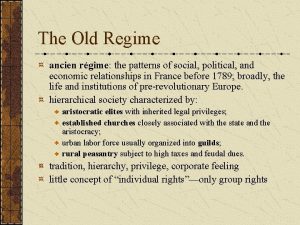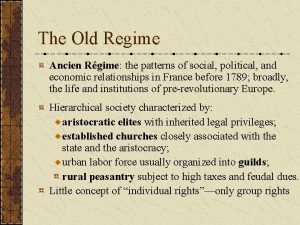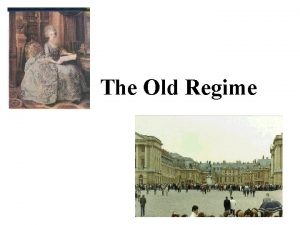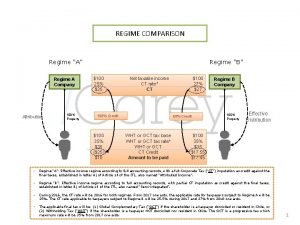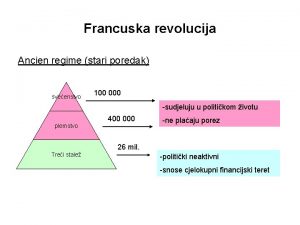18 th Century The Old Regime ancien regime
























- Slides: 24

18 th Century – “The Old Regime” (ancien regime) Society and Economy

Meaning of “Old Regime” • Life and institutions of “pre-revolutionary” Europe • Politically- mostly absolute monarchies (not in UK) • Economically – pre Industrial; traditional economies based on subsistence agriculture • Socially- people saw themselves as members of a class with group privileges üEstablished churches üInherited titles üRural peasants – feudal taxes

Change was beginning; the roots of transformation were fermenting: • Food production and population was increasing • Early stages if IR were beginning, goods more available • Colonies in America creating a demand; merchants growing • Spirit of rationality (Sci. Rev) new technology

Major Features of Life in the Old Regime Traditiona l • Past more important than the future • Both nobles and peasants favored “customary rights” • Protection of nobles from monarchy, of peasants from nobility Hierarchy • Medieval social class system • “sumptuary laws” regulated dress within classes Privilege • No concept of “individual rights” • Rights and privileges were held by groups and communities (i. e. towns, guilds, etc.

The Aristocracy LAND 1 -5% of population Tax exempt Wealth &Power Parliament (House of Lords and Commons) Birth and legal privileges Government offices

Varieties of Aristocratic Privilege: British French Eastern Europe • Smallest, wealthiest • 400 families • Controlled BOTH houses of Parliament – they both levied AND paid taxes • Only eldest son inherited “peerage” • Younger sons moved into commerce, military, etc • Invested in commerce • “Game Laws” – exclusive right to hunt • Exempt from any tax • divided between “sword” and “robe” • Exempt from the “corvee” • Some favored by the royal court and became enriched • Others in countryside less well off • Untl 1768 Polish nobles had the right of death over serfs • Peter “created” nobility with his Table of ranks (1722) • In general: exempt from taxes and power over serfs

The state of agriculture in 1700 • Peasants and artisans had about the same standard of living as in the Middle Ages • Most people battled hunger and lacked sufficient clothing and decent housing • Agriculture had changed little since the Middle Ages Ø 80% of western Europe’s population were farmers; percentage was even higher in eastern Europe • The Netherlands was the only exception; more urban and mercantile Ø Agricultural output was very low compared to modern standards • Medieval open field system was predominant • Failed harvests occurred once or twice a decade, on average resulting in famines • People were malnourished, making them more susceptible to disease • Science was essentially a branch of theology and had no real application in agriculture

Peasants and Serfs: English and French Cultivators Germany, Austria and Hungary “banalities” – (fr) –feudal dues and required “use for payment” for mills, ovens, etc Use of “robots” in Hapsburg lands Corvee - forced labor Serfs in Russia –wealth measured in serfs. Could require 6 days/week labor! Could sentence serfs on estate. Serfdom=slavery Paid rent and taxes Almost complete control of serfs on manors England – small farmers and tenants had the sane legal rights as all Engishmen

Pugachev’s Rebellion • 1773 -1775 • Largest peasant rebellion of the 18 th century (Russia had at least 50) • Promised land freedom to serfs • Brutally repressed by the goverment • Essentially conservative in nature: üDirected against property üUsually sought restoration of rights rather than new ones

Life in the 18 th Century Marriage and the Family prior to 1750 • The nuclear family was the most common in pre-industrial Europe. • Young married European couples established their homes apart from their parents. • 3 -generation households usually entailed a parent moving in with a married child. – On average, the age at marriage was higher prior to 1750, especially for the lower classes • Late 20 s or older for both men and women • Couples could not marry until they could support themselves economically. • Peasant sons often had to wait until their father’s death to gain land (through inheritance). • Peasant daughters and family had to accumulate a small dowry to help her future husband to buy land or build a house.

• Some areas required legal permission or approval of local lord or landowner for marriage. • Austria and Germany had legal restrictions on marriage well into 19 th century. • Local governments believed that without regulating marriages, lower classes would create more paupers, abandoned children and more gov’t money would need to be expended on welfare. • This pattern helped maintain some balance between population and resources. – Many men and women never married. • Approximately 40% to 60% of women between 15 & 44 were unmarried at any given time. Children • Rate of births out of wedlock was fairly low • Reflected powerful social controls of traditional villages • If wife & husband lived to age 45, odds about 50% of giving birth to 6 or more children. • Infant mortality was high. – 20% in economically viable areas. – 33% in poorer areas. – 50% survival rate into adulthood was considered good.

After 1750 : New Patterns The growth of the cottage industry with its increased income resulted in higher rates of people marrying for love instead of just purely economic reasons. • Young people did not have to wait as long to become financially independent. • Arranged marriages for economic reasons declined • Laws and regulations on marriage, especially in Germany, were often ignored. • Factory workers after 1780 followed marriage pattern of cottage workers. •

• The explosion of births was caused by increasing illegitimacy: 1750 -1850. • Illegitimacy rates as high as 33% in certain areas. . • Mobility encouraged new sexual and marital relationships which were less subject to parental pressure and village tradition. • In Germany, illegitimate births were a result of open rebellion against class laws limiting marriage among the poor. – Illegitimacy declined when marriage restrictions were rescinded. • Women in cities and factories had limited economic independence. • Young women were not motivated by visions of emancipation and sexual liberation. • Most city women probably looked to marriage and family life as an escape from hard lifestyle. • Many intended marriages did not take place as poor economic and social conditions scared men away from the commitment.

Attitudes toward children began to change during the 18 th century Child care and nursing • Poorer women generally breast-fed their infants for much longer periods than in the 20 th century. • Resulted in spacing births of children from 2 to 3 years apart due to decreased fertility. • Infants more likely to survive on mother’s milk than on artificial foods. • Women of aristocracy and upper-middle class seldom breast-fed • This was also true of wives of artisans who lived comfortably • Believed it was crude, common and beneath their dignity. • Wet-nurses hired to breast-feed their children. • Many babies sent to countryside • Wet-nursing took two to three years

Infanticide • Early medieval church denounced infanticide; viewed each human life as sacred. • Yet, infanticide was rampant due to severe poverty. • “Overlaying” occurred in many cases with a parent rolling over and suffocating a child in bed. Foundling hospitals emerged, first in Paris then throughout Europe • Many poor women left babies on the doorstep of churches. • By 1770, 1/3 of all babies born in Paris were immediately abandoned to the foundling home; 1/3 of those came from married couples. • Foundling home in St. Petersburg cared for 25, 000 babies in the early 19 th century; receiving 5, 000 new babies a year. • Half of all babies died within a year; at worst, 90% died.

Child-rearing • Children were often treated indifferently and with strict physical discipline. • Because of such high mortality rates, parents were reluctant to become too emotionally attached to their children. • Doctors often declined to care for sick children believing there was little that could be done. • “Spare the rod and spoil the child” –term coined by novelist Daniel Defoe • Many children worked in factories at a young age and were severely disciplined. • Many believed the task of parents was to break their will to make them obedient. • Humanitarianism and Enlightenment optimism regarding human progress emphasized better treatment of children. – Rousseau encouraged greater love and understanding toward children. – Increasingly, parents grew closer to their children.

Education • The beginnings of formal education for the masses took root; largely inspired by Protestantism. • Aristocracy and rich had a two-century head start beginning in the 16 th century with special colleges, often run by Jesuits. • “Little schools” of elementary education began to appear in 17 th century. • Boys and girls from age 7 to 12 were instructed in basic literacy and religion. • The Church of England “dissenting groups” such as the Puritans founded “charity schools” to instruct poor children. • Scotland created a network of parish schools for all citizens to teach reading of the Scriptures.

• France established Christian schools starting in 1682 which taught religion as well as reading and writing. • Starting in 1717, Prussia led the way with universal compulsory education. – Inspired by old Protestant idea that every Christian should be able to read the Bible • Education also seen as way to make the population effectively serve the state. • Enlightenment commitment to greater knowledge through critical thinking reinforced interest in education during 18 th century. • Literacy by 1800: – – Almost 90% of Scottish male population; only 1 in 6 in 1600. 2 out of 3 males in France; in Normandy, 90%; only 1 in 6 in 1600. Over 50% of male Brits; only 25% in 1600. Women were increasingly literate but lagged behind men in general.

Increased life expectancy http: //www. youtube. com/watch? v=jbk. SRLYSojo

The life spans of Europeans increased from 25 to 35 years in the 18 th century. • Largely the result of the disappearance of the plague and starvation. • More time spent by children on education and preparation for adulthood. Development of public health techniques important breakthrough of 2 nd half of 18 th century. • Improved practices in sanitation. • Mass vaccinations (see Jenner to follow) • Better clothing (due to proto-industrialization) • Improvements in developing warm dry housing. • Adequate food (due to the agricultural revolution

Diet and nutrition underwent significant changes during the 18 th century. • The diet of ordinary people improved. • Poor people’s diets usually consisted of grains and vegetables. • The potato improved the diet of the poor with vitamins A and C. • Most Irish lived almost exclusively on the potato; lived in abject poverty – Average male ate 8 to 10 lbs a day! – The crop produced more food per acre • By end of 18 th century, potato an important food in much of Europe.

Nutrition (con’t) • Greater variety of vegetables existed in towns and cities • c. Upper classes consumed much meat and fish and alcohol. • Few fruits and vegetables eaten. • Greater affluence meant that some people indulged in less nutritious food (e. g. sugar). • d. Northern, Atlantic Europe ate better than southern, Mediterranean Europe. • The English ate the best of all

Medical improvements • The bubonic plague had largely disappeared from Europe in the 17 th century. • This was due to the increased resistance to the disease, the displacement of the Asian black rat, and better hygiene, improved public health and sanitation The conquest of smallpox was the greatest medical triumph of the 18 th century. • 17 th century: 25% of deaths in Great Britain caused by smallpox • Smallpox killed perhaps 60 million people in the 18 th century; 400, 000 per year on avg. • 80% of Europeans contracted it; many were scarred for life • Lady Mary Wortley Montagu introduced a Turkish technique of vaccination in the 18 th century but it was roundly criticized

Edward Jenner (1749 -1823) • 1778, created the foundation for the science of immunology with his vaccine for smallpox. • Discovered inoculating patients with cowpox would control onset of small pox. • d. Humanitarianism of late 18 th century led to hospital reform. • Ventilation improved and filth eliminated as disease believed to be caused by bad air. • Spread of infection was reduced • First humane mental hospital founded in England in 1790
 The ancien regime
The ancien regime War with austria french revolution
War with austria french revolution Esprit grec ancien
Esprit grec ancien Old regime french revolution
Old regime french revolution What is the old regime in france
What is the old regime in france Old regime 3 estates
Old regime 3 estates Once upon a time there lived an old man
Once upon a time there lived an old man Once upon a time there lived an old man and an old woman
Once upon a time there lived an old man and an old woman Once upon a time there lived a father
Once upon a time there lived a father And how old are you
And how old are you Thang điểm glasgow
Thang điểm glasgow Tư thế ngồi viết
Tư thế ngồi viết ưu thế lai là gì
ưu thế lai là gì Thẻ vin
Thẻ vin Voi kéo gỗ như thế nào
Voi kéo gỗ như thế nào Thơ thất ngôn tứ tuyệt đường luật
Thơ thất ngôn tứ tuyệt đường luật Các châu lục và đại dương trên thế giới
Các châu lục và đại dương trên thế giới Từ ngữ thể hiện lòng nhân hậu
Từ ngữ thể hiện lòng nhân hậu Diễn thế sinh thái là
Diễn thế sinh thái là Frameset trong html5
Frameset trong html5 V cc cc
V cc cc 101012 bằng
101012 bằng Bài hát chúa yêu trần thế alleluia
Bài hát chúa yêu trần thế alleluia Lời thề hippocrates
Lời thề hippocrates Sự nuôi và dạy con của hươu
Sự nuôi và dạy con của hươu































